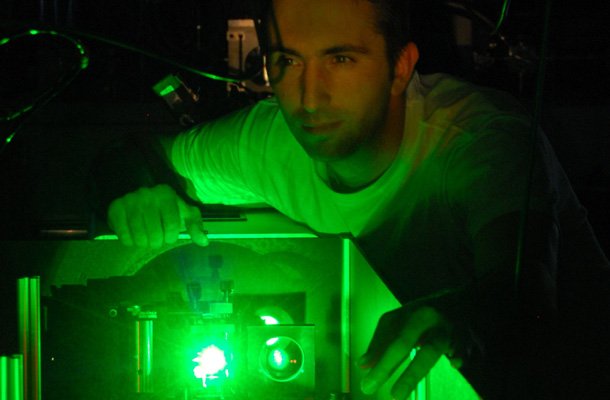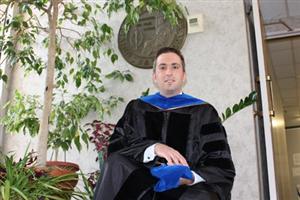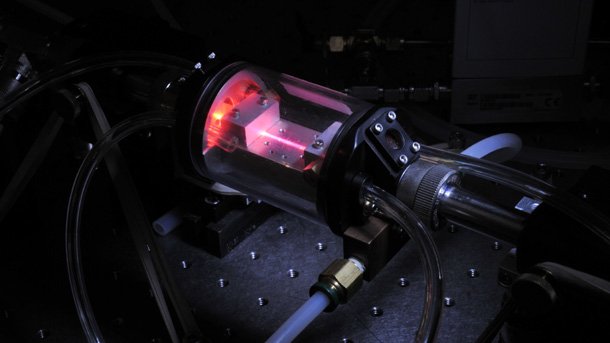
“The feeling that you have achieved something practical, something useful for many people via your research – this is a unique experience,” says Dr. Tenio Popmintchev, whose scientific interests are in the areas of atomic, molecular and optical physics. Total dedication – this is the secret of success, according to the scientist. His name appeared in the world’s most distinguished scientific magazines, also millions watched him on CNN and BBC. That all happened after last year’s publication in the Science magazine of the news that an international team of physicians had developed the first of its kind tabletop X-ray laser that can be used for biological, physical and other kinds of scientific researches.
The young man was born in 1977 in the town of Stara Zagora, but grew up in the Valley of Thracian Kings, in the town of Kazanlak. He graduated the local High School of Natural Sciences and Maths, where he opted for the complex and challenging world of science. The path was shown by famous teacher in physics Teodosyi Teodosiev, who helped his hesitant student in his choice between maths and physics. “He told me then that all physicians were better mathematicians and gave Newton as an example,” the young scientist recalls, admitting that:
“That made me opt for physics and as of the 7th grade I started to deal with this science. I have always been a part of the extended team at the international contests in physics, but I wouldn’t say that I was an exceptional competitor. I have participated in two Olympiads – in Beijing and Oslo and a bronze medal was my best achievement. The interesting thing is that my teacher reminded me that my experimental results were included back then in the monitoring book of one of the Olympiads. There was even a period, when I intended to forget about physics, since I entered the Sofia University with a national diploma, which allowed to me to pick up any specialty with no exam. Of course, there were other alternatives too, but now I realize that 7 – 10 years are necessary to become an expert, recognized across the globe. I felt somehow like an expert and that is why I went on with physics. Later on Prof. Ivan Hristov from the Sofia University recommended me to the scientific team from the Colorado University that he used to work with. It is nice to work with the best master in the world. Masters teach best, not books or institutions.”

© Photo: private archive
Tenio Popmintchev had his master’s in laser physics with the Sofia University. In 2010 he had his PhD at the University of Colorado in Boulder, USA. In 2011 his thesis was selected by the American Physical Society among Top 4 in the world in the area of atomic, molecular and optical physics. At the moment Dr. Popmintchev is a senior research fellow at the JILA Institute with the University of Colorado. The institute is a world leader in the area of atomic, molecular and optical physics with three Nobel prizes over the past decade.
The international team, headed by Dr. Tenio Popmintchev managed to create in its laboratories the first tabletop X-ray laser with ultra-short pulses. The device fits in a palm and is actually the laser version of the x-ray lamp of the first Nobel Prize laureate in physics Wilhelm Röntgen. “The main challenge is that the creation of an x-ray laser needs a lot of energy, equal to the energy of an atomic weapon,” the Bulgarian scientist explains. Another contribution of the scientific discovery is that the researchers succeeded in synchronizing the emission of millions of atoms, in order for strong radiation to be achieved. “That was exactly that synchrony that was impossible over the 25-year-long history of this relatively young process in physics,” Dr. Popmintchev explains. The fact that the invention is so compact is another advantage. The main obstacles for the large-scaled usage of the currently existing facilities are their price and size – the first laser installations could “praise” with the size of a football stadium, or take the latest generations that require multibillion investments with their size of 1 – 8 km.
“For a first time we have x-rays with laser features and the facility is that compact,” the expert explains. “Maybe these are the new eyes of science that can catch ultra quick processes in their natural time and spatial scale, i.e. we can photograph the movement of the electron, the quickest quantum particle outside the nucleus. In other words we have the camera with the fastest flashlight, with some spectacular scale, compared to the visible world. The flashlight : 1 sec. ratio is near to the ratio 1 sec. : the age of the Universe! We are all aware of the advantages of x-ray treatment – from medicine to the airport scanners. The x-ray light has led to a series of major discoveries, such as the double helix structure of DNA. You can see that the resolution of the first medical picture, taken by Rontgen more than 100 years ago is not that different from the resolution of those photos from the modern dental cabinets and hospitals. The reason is that x-ray light is not coherent, i.e. it is not a laser, but is similar to everyday light that we have used since Edison. It can’t be focused and cannot achieve higher resolution.”

© Photo: private archive
The patent of the new invention has been recently granted. A series of companies have already shown huge interest to it: IBM, Intel, AMD, Hitachi, Sematech etc. The Samsung has sent its experts to the JILA laboratory to assess the potential of the facility for their applications. The invention can be used in fundamental science, industry, nanotechnologies, for the creation of the next generation ultra quick microcomputers and nano hard drives. The next developments of the technology could lead to early diagnoses of diseases.
“I can see facilities of that kind in each hospital in the near future, increasing the resolution of every picture. The x-ray pictures cannot provide enough information right now. Sometimes the disease has progressed and can be seen barely then. Besides that the zone that we irradiate with our laser is a miniature, unlike the x-ray lamp that seizes the whole body.”
Tenio Popmintchev has been living and working in the USA for some 10 years. He says that the lack of too much free time is not his concern, since he has discovered his vocation. His hobbies outside the lab: tennis, golf and history.
English version: Zhivko Stanchev
"The place in France where we draw together the future of our children in Bulgarian" - this is how Yaneta Dimitrova described her workplace - the Bulgarian Sunday School "Ivan Vazov" in Paris a year ago in a post on a social network. It is one of the 396..
21 February is International Mother Language Day, first proclaimed as such by UNESCO and later adopted by the UN General Assembly. The right to study and to speak one’s mother tongue, or native language, is a basic human right and a civil right..
152 years after the death of the Apostle of Freedom, the personality of Vasil Levski continues to excite Bulgarians, regardless of whether they are in the country or abroad. The Embassy of Bulgaria in Athens, Greece , has extended an invitation to the..
21 February is International Mother Language Day, first proclaimed as such by UNESCO and later adopted by the UN General Assembly. The right to..
"The place in France where we draw together the future of our children in Bulgarian" - this is how Yaneta Dimitrova described her workplace - the..

+359 2 9336 661
